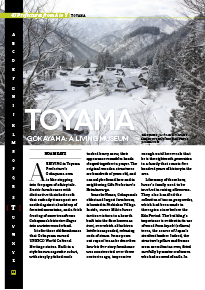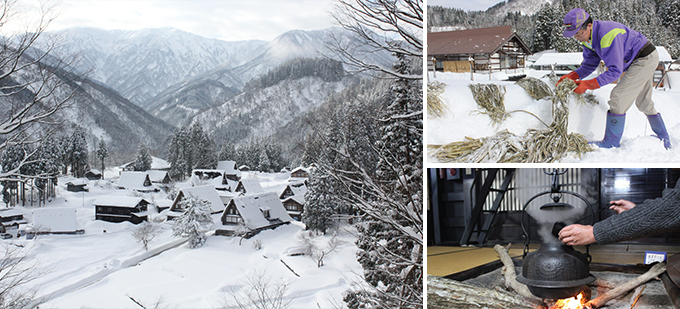Home > Highlighting JAPAN >Highlighting Japan February 2015> 47 Prefectures from A to Y
Highlighting JAPAN

47 Prefectures from A to Y
Toyama
Gokayama: A Living Museum

Arriving in Toyama Prefecture’s Gokayama area is like stepping into the pages of a fairy tale. Rustic farmhouses with distinctive thatched roofs that embody times past are nestled against a backdrop of forested mountains, and a thick frosting of snow transforms Gokayama’s historic villages into a winter wonderland.
It is for these old farmhouses that Gokayama earned UNESCO World Cultural Heritage status. Built in a style known as gassho-zukuri, with steeply pitched roofs to shed heavy snow, their appearance resembles hands clasped together in prayer. The original wooden structures are hundreds of years old, and can only be found here and in neighboring Gifu Prefecture’s Shirakawa-go.
Iwaseke House, Gokayama’s oldest and largest farmhouse, is located in Nishiakao Village. Inside, owner Mikio Iwase invites visitors to a hearth built into the floor known as irori, over which a black iron kettle is suspended, releasing curls of steam. Iwase pours out cups of tea as he describes how his five-story farmhouse was constructed over three centuries ago, impressive enough until he reveals that he is the eighteenth generation in a family that counts five hundred years of history in the area.
Like many of those here, Iwase’s family used to be involved in raising silkworms. They also handled the collection of tax on gunpowder, which had been made in the region since before the Edo Period. The building’s importance is evident in its use of wood from keyaki (zelkova) trees, the source of Japan’s sturdiest lumber. Indeed, the structure’s pillars and frames seem as resilient as ever, fitted carefully by master craftsmen who had no need of nails. In contrast, the thatched roofs require replacement every twenty-five years, and Iwase laments that the cost and intense effort required to maintain them has caused the number of farmhouses to dwindle from 1,600 some sixty years ago to a mere 200 today.
Touring these living museums is fascinating enough, but visitors can also lodge overnight for a fuller experience. At Ainokura Village, a stay at the inn called Yusuke is a way to immerse yourself in farmhouse life little changed from the past: sitting down around the irori eating meals made with mountain vegetables, sleeping under fluffy, warm futons set out on tatami mats, and bathing in fragrant hinoki (Japanese cypress) tubs.
An agricultural livelihood produced songs and dances for work in the fields as well as festivals to celebrate harvests, giving Gokayama a rich tradition of folk music. That may include a local adorned in the traditional garments worn by regional samurai and playing a unique musical percussion instrument called a sasara dancing to the Kokiriko folk song, thought to be Japan’s oldest. In bygone days, this song and dance was performed to pray for bumper crops and to thank farmers for their hard work.
Gokayama offers countless opportunities to observe other traditional activities. Local craftsman Kenzo Miyamoto, for example, is keeping alive the traditional way of making washi (Japanese paper). Miyamoto is patient about explaining the various steps involved, which include bleaching the inner bark of the kozo (paper mulberry) tree in the snow, separating and then pressing the fibers, followed by drying out the sheets and so on. His high-quality natural paper has even been used in the restoration of Japan’s important national cultural properties.
Gokayama’s nostalgic scenery makes it a special place in any season. But there are few better ways to understand the unique history of Japan’s countryside than in a centuries-old traditional farmhouse, hearing tales of the past surrounded by the warmth of an irori during frigid winter days.
© 2009 Cabinet Office, Government of Japan






